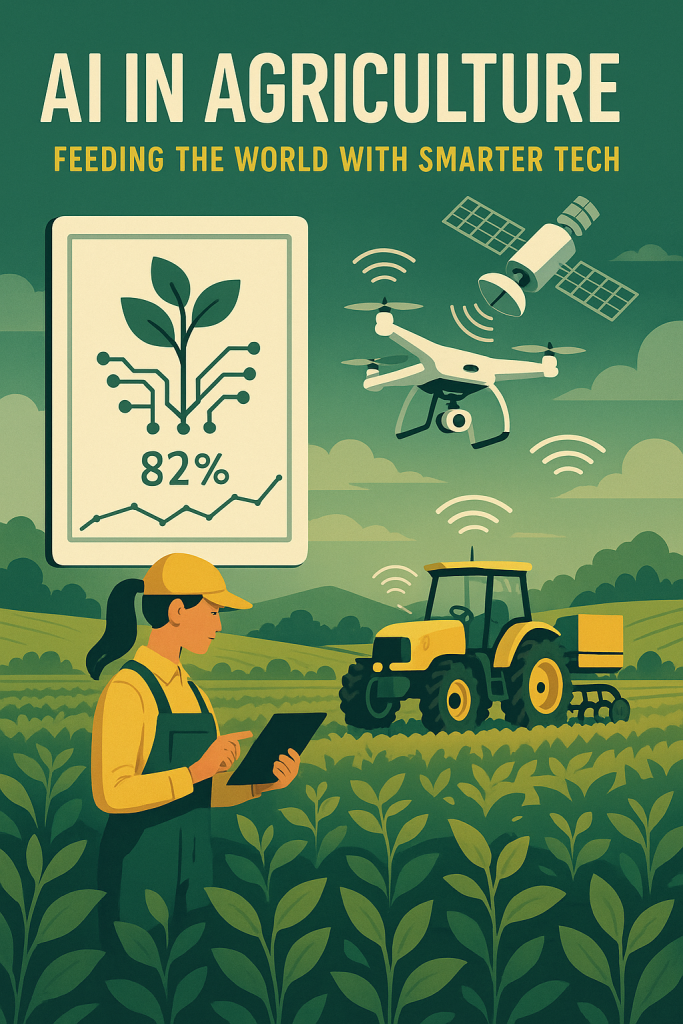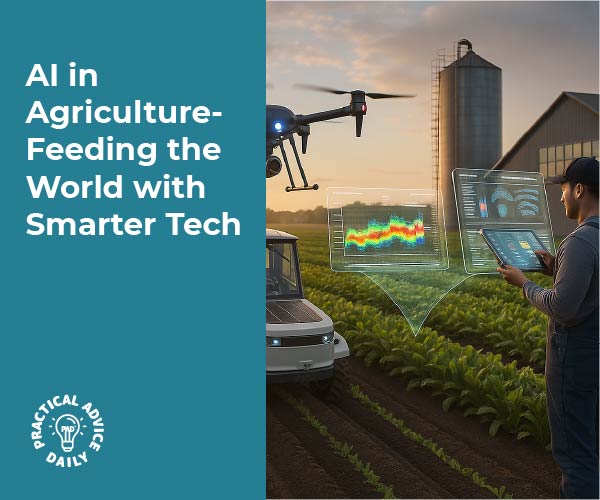Farming has always been about balance—getting the most out of the land while using resources wisely. Today, farmers face big challenges, from climate change to feeding a growing population. The good news is that new technology, especially artificial intelligence (AI), is helping. With AI, farmers can watch over crops more closely, use water and fertilizer more carefully, and even predict problems before they happen.
In this article, we’ll explore how AI is being used in agriculture and why it matters to all of us. We’ll also share simple ways you can try similar technology at home in your garden.
Table of Contents
Key Takeaways
- AI helps farmers monitor crops with drones and smart sensors.
- Technology reduces waste by using water, fertilizer, and pesticides only where needed.
- AI can predict plant diseases and weather patterns to prevent crop loss.
- Smarter farming means more food for a growing world population.
- Everyday gardeners can also try AI tools for healthier plants and less waste.
How AI Is Changing Farming
1. Smarter Crop Monitoring
In the past, farmers had to walk through fields to check crops. This was time-consuming and sometimes problems went unnoticed. Today, AI-powered drones can fly over large areas in minutes. Equipped with cameras and sensors, they collect images of plants. AI software then studies these pictures to spot early signs of disease, dryness, or pests.
Real-life example: A farmer in India uses drones to scan his rice fields. The AI system highlights patches that are too dry. Instead of watering the entire field, he can target just those areas. This saves water and reduces costs.
2. Predicting Plant Health
AI doesn’t just see what is happening now—it can also predict the future. By looking at patterns in weather, soil quality, and plant growth, AI tools can warn farmers of possible issues.
Example: A grape farmer in California uses AI to predict when vines are at risk of a fungal disease. Early warnings allow the farmer to treat only the areas at risk, rather than spraying the entire vineyard.
3. Reducing Waste with Precision Farming
One of the biggest breakthroughs is “precision farming.” This means using the exact amount of water, fertilizer, and pesticides a crop needs—no more, no less. AI gathers data from soil sensors and weather forecasts to guide farmers.
Step-by-step look:
- Sensors in the soil measure moisture and nutrients.
- Data is sent to an AI program.
- The program advises how much water or fertilizer to use.
- Automated machines or irrigation systems carry out the instructions.
This careful approach reduces waste and lowers costs while protecting the environment.

4. Smarter Machinery
Tractors and harvesters are also getting an AI upgrade. Self-driving tractors can plant seeds in straight lines with incredible accuracy. AI-guided machines can sort harvested crops, separating good produce from damaged ones.
Example: Some farms use AI-powered cameras on sorting lines. These machines quickly identify which tomatoes are ripe, saving workers hours of labor and ensuring only the best produce reaches stores.
5. Better Planning with Data
AI also helps with big-picture planning. By analyzing years of weather records and crop yields, AI systems can recommend the best times to plant and harvest. They can also help decide which crops are most likely to succeed in a given year.
Example: A farmer in Kenya uses an AI app that suggests which crops will handle upcoming dry conditions. By switching to drought-resistant maize, the farmer avoids major losses.
How This Affects All of Us
Even if you don’t live on a farm, AI in agriculture still matters. Smarter farming leads to:
- Lower food prices because waste is reduced.
- Fresher produce because farmers can plan harvests better.
- A healthier planet because fewer chemicals and less water are wasted.
Try It Yourself: Everyday Tech for Gardening
You don’t need a large farm to experience AI in action. Home gardeners can also use smart tools that bring AI-powered farming ideas to your backyard or even a balcony garden.
Here are some practical examples:
- Soil sensors for pots or gardens
Small devices you stick into the soil measure moisture, light, and temperature. They connect to an app on your phone, which tells you when to water or move your plants. - Plant care apps
Snap a photo of your plant, and AI can identify its type and spot common diseases. Some apps even recommend care routines based on the season. - Smart sprinklers
These devices link to weather apps. If rain is expected tomorrow, the sprinkler will skip watering today, saving water and preventing overwatering. - AI-based garden planners
Simple online tools let you design your garden layout. They suggest the best placement for vegetables based on sunlight and climate in your area.
Beginner’s Smart Gardening Checklist
If you’d like to bring some of these ideas into your daily life, here’s a simple step-by-step checklist to get started:
- Pick one plant to experiment with.
Start small—maybe a tomato plant, herb pot, or a flower you enjoy. - Download a plant care app.
Choose one that lets you take photos for identification and gives watering reminders. - Try a budget soil sensor.
Place it in your pot or garden bed. Check the app to learn when the soil is dry or too wet. - Set up a smart watering schedule.
If you have outdoor space, consider a smart sprinkler or drip system that adjusts based on weather. - Keep track of results.
Note whether your plant looks healthier, grows faster, or uses less water. - Expand slowly.
Once you’re comfortable, add sensors or apps for more plants, or try AI garden planners to design a vegetable patch.
This checklist gives you a taste of what farmers are doing on a much larger scale, right in your own home.
Final Thoughts
AI in agriculture may sound futuristic, but it’s already here and growing fast. Farmers are using it to protect crops, save resources, and feed more people. For everyday people, it means safer food, lower costs, and a greener future.
And you don’t need acres of farmland to try it yourself. With simple apps and tools, you can bring smarter gardening to your backyard or even a single potted plant on your windowsill. The next time you enjoy a fresh salad or piece of fruit, remember that AI might have played a role in bringing it to your table—and maybe even into your garden.
